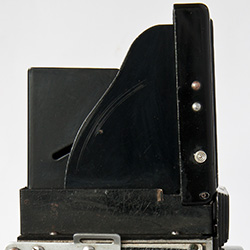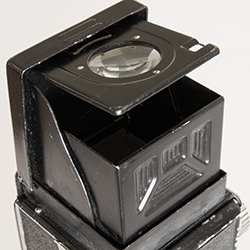66 Models
The 66 Models are in chronological release date order split over seven pages to speed up loading. The page groupings of cameras are based primarily on length but I have tried to keep related models together as much as possible. Whilst the Yashica 24, Yashica 12 and Yashica Mat-124 are all significant models with key differences, they are also very similar and therefore, I have put them together under one entry to make it easier to compare and contrast their features and small trim changes.
These pages do not generally repeat all the information appearing in other sections. Therefore, to get a full picture of a model may require reference to the Models & Specs, Bodies & Trim and Lenses & Shutters pages and also Yashicaflex A Series, if appropriate. Other relevant references are usually linked. If serial numbers do not make sense, reference to the Serial Numbers page may help understand why that is.
Notes
1. Serial Numbers:
Whilst currently there are over 4800 entries in my 66 database, I have photos of many other cameras which are not in the database. Database entry for common models usually requires a discernible body serial number at least. For less common models or important transition features, a single lens number, or part thereof, may be enough to gain entry.
Serial numbers, where given, reflect my observations only. They are often hard to see, or on hidden parts of cameras and I have been interested more in some models than others. Also, some models just don’t appear very often and/or they appear on sites where the resolution of images makes them more difficult to discern. Therefore they are an indicator only. In most cases, I have shown the last 3 digits as xxx (with some 5 digit numbers, the last 2 digits as xx) simply because it has not been possible to obtain the owner’s permission. Where numbers are shown in full, the items are either mine, or permission has been obtained.
Where I rely on lens serial numbers, I will show these in italics as a reminder. I generally use the terms “taking lens” and “viewing lens” but if I don't use those terms, a lens number by itself means taking lens and if there are two lens numbers, then taking lens always comes first. I rarely quote viewing lens numbers as they have similar ranges to taking lenses, although with some camera models, they can be wildly out of sequence. When there are body serial numbers, I only quote lens numbers occasionally to give an idea about the sequence pattern.
2. User Manuals: I have added images of user manual covers where available (does not include Orphan Cameras manuals) to indicate range and versions available. Some early ones cover more than one model and therefore appear more than once. There are often more versions available than shown, particularly with long running models. With the exception of the Yashica Flex B, Yashicaflex S, Yashicaflex A, combined Yashicaflex A and C, Yashica Flex and Yashica-Mat Photography books, Yashica A2 (Yashicaflex A2), Yashica Rookie, Yashica AS (Yashicaflex AS), Yashicaflex B, middle Yashica 635, Yashica Mat-EM Japanese version, Yashica Mat-124G 66 and Yashica Mat-124B covers, cover images are provided courtesy of Tom Heckhaus (some of the linked manuals are courtesy of others, as noted).
Of the models with no user manuals shown, the models themselves are reasonably scarce so the likelihood of finding a manual now is not high.
For the benefit of anyone researching early models, I have linked the Yashicaflex S user manual scanned by eBay seller Kathryn, my user manual for the Yashicaflex A models (A-I and A-II), combined Yashicaflex Models A and C (including the Yashicaflex S and AS attachment); Tom Heckhaus' manuals for the Yashicaflex AS models (AS-I and AS-II) and Yashica Auto; Leigh Harris' Yashicaflex A2 instruction sheet and selected pages from the very early Swedish Yashica-Mat manual provided courtesy of Göran Årelind. As most of the questions from correspondents concern the later models, I have now also linked other manuals I have plus Göran Årelind's Yashica C and Yashica 44A manuals; Chris Whelan's Yashica A version 1 and Yashica 12 manuals and Tom Heckhaus' Yashica A version 2 and 3 and Yashica 24 manuals. All the available manuals are also consolidated here.
Chris Whelan has contributed selected pages from three Japanese “Yashicaflex Photography” books which are in effect user manuals as well as a more extensive photography guide. The first covers the models S, A-II and C, the second is for the model B and the third for the Yashica A III. I have added selected pages from my “Yashica Mat Photography” which is very similar. Chris has also also contributed a scan of the full Japanese version of the Yashica Mat-EM user manual. Details and access is consolidated here.
3. Brochures: I have included brochures for the Yashica Flex S (at the top of the entry, all others at the bottom), Yashica Mat-LM, Yashica E, Yashica Mat-EM, Yashica 24, Yashica Mat-124 and Yashica Mat-124G which are with their respective model entries. Brochures covering more than one model are available as PDF downloads from the Brochures page which consolidates access to all brochures on the site including the ones linked from these pages.
1953 to 1954
Pigeonflex to Yashicaflex B
Models
(Scrolling will take you down to the bottom of the page that you are on, clicking on links will take you to that model regardless of the page that you are on.)
1953-1954 The Simple Beginning |
||
| Pigeonflex | Yashima Flex | |
| Yashica Flex B | ||
1954 A Step Up - Japanese Icon |
||
| Yashica Flex S | ||
1954-1955 Full Range of Models Released |
||
| Yashicaflex A-I | Yashicaflex A-II | |
| Yashicaflex AS-I | Yashicaflex AS-II | |
| MolfoReflex | Yashicaflex C | |
| Yashicaflex A-III | ||
1956-1957 The “Yashica” is born |
||
| Yashica Rookie | Yashica Hi-Mec | |
| Yashica A | Yashica C | |
| Yashica LM | Yashicaflex A2 | |
1957 First Crank Wind and Last “Yashicaflex” models |
||
| Yashica-Mat | Yashicaflex AS (new model) | |
| Yashicaflex B (new model) | Yashicaflex A (new model) | |
1958-1959 The Classics, the 635 and D, Released |
||
| Yashica 635 | Yashica B | |
| Yashica D | Yashica A III | |
| Yashica Auto | ||
1960-1986 Crank Wind Sophistication plus Automation |
||
| Yashica Mat-LM | Yashica E | |
| Yashica Mat-EM | Yashica 24, 12 & Mat-124 | |
| Yashica Mat-124G | Yashica Mat-124B | |
Pigeonflex
Genesis
Probable release date |
Mar 1953 |
Probable end date |
May 1954 |
Lens |
Filter Mounts |
Frame Counter |
Shutter |
|||
Make/Type |
Sync |
S/Timer |
Speeds |
|||
Tri-Lausar |
32 mm |
Red Window |
NKS |
Yes |
Yes |
B,1-1/200 |
 1.jpg)
.jpg)
 1.jpg)
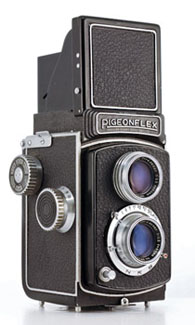

(Image 4 courtesy of Tom Heckhaus, image 5 courtesy of Rick Sweeney)
Five Yashima Pigeonflex examples; the first three (all with missing focusing hood leatherette) have rear-set magnifier release (knob missing on the second one) with half round magnifier frame and more curved name. The first example, the earliest Pigeonflex found so far, has different shutter trim to later types, the second example, the fifth earliest found, has the new shutter trim but still the earliest company name on the nameplate and arrow without feathers on the locking lever. The third example is similar but has the new maker name and arrow with three spikes. The fourth example (it has been re-covered), has front-set magnifier release with new square shaped magnifier frame and less curved name. The fifth example (also re-covered) is without maker name and has last type hood with finger grip knob. Full details of variations below.
What motivated Yashima to build a camera in the first place and how much of it was designed and made in-house, or was most of it initially bought in and simply assembled, we just don't know. However, we can surmise that Yashima either did produce most of it in-house, or, it gradually took over responsibility for producing the same components - the 17 year transition to the release of the Yashica Mat-124G was a gradual one. There is no point at which a design was changed completely as happened with some other makers as they shopped around for parts.
Identifying the Yashima Pigeonflex Variations
It is a common belief that the first Pigeonflex was made by Yashima for marketing company Endō Kamera-ten (Endō Camera Stores), later to become Endō Sashin Yōhin (Endō Photographic Supplies), but after the release of the Yashima Flex, the new Pigeonflex model IA and following models were manufactured by Shinano Kōki. Whereas there are visual similarities between the IA and the Yashima Flex particularly, the other models are so different that I think that another maker, Alfa Optical Co., is involved in some way. And there is at least one more model not identified by anyone else that I think is made by Tokiwa Seiki. To top that off, Camera-wiki thinks that the earliest ad for the Pigeonflex shows a Yashima made camera with “decorative silver plate behind both lenses” whilst ignoring that it has a sports finder in the hood and other differences not found on Yashima made examples including the lack of maker name on the nameplate. I think that it is more likely made by someone else unknown. So there you have it, another controversy - Yashima may not be responsible for the earliest Pigeonflex. There is more information including details of the other Pigeonflex models on the The Pigeon Loft page.
Although claimed by Camera-wiki.org to be first advertised in March 1953, that seems to feature the camera with the lens decoration and sports finder so take that date with a grain of salt but the first half of 1953 is probably right. Yashima's Pigeonflex had the Company’s name, Yashima Seiki Co., Ltd., just under “Pigeonflex” on the front nameplate (first two cameras above, first example below). When the Company changed its name in June 1953 to Yashima Kōgaku Seiki Co., Ltd., this was also reflected in the nameplate (third and fourth cameras above, second camera below). Later cameras received a modified nameplate with subtly less curve to the name (fourth and fifth cameras above, third and fourth cameras below). Then the maker name was omitted (fifth camera above, fourth camera below), more details further down.
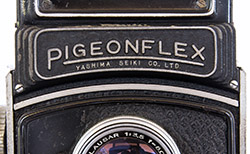
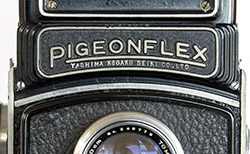
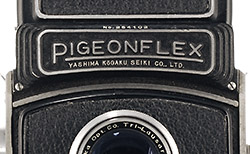
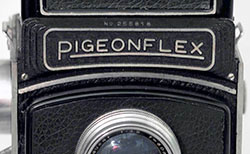
(Image 3 courtesy of Tom Heckhaus, image 4 courtesy of Rick Sweeney)
As noted earlier, the locking lever arrow on early examples have no feathers or spikes (see also Tripod Mounts/ Locking Knobs):
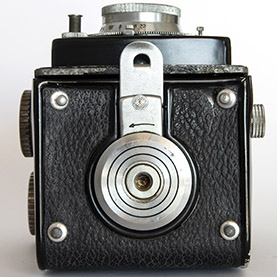
However, the feathers appeared very early on, certainly before the new company name. The third camera from the top foursome is featured below. Note that all Yashima credited Pigeonflexes have the ASA bayonet type flash sync socket on the side, this style of red window (same as Yashima Flex and Yashica Flex B, anything else is credited to Shinano, or someone else - note the diamond shaped window itself, the Shinano Pigeonflex model IA has the same style window assembly but with circular window cut-out), this style of locking lever and tripod mount and Tomioka Tri-Lausar lenses with f/3.5 viewing lens:
 3.jpg)
 4.jpg)
 018small.jpg)
The information from Camera-wiki.org is that later Pigeonflexes made by Shinano were fitted with Pigeonar lenses except for the IB model with Tri-Lausars but that is easily distinguishable with its faceplate trim which is somewhat similar to the later Yashicaflex A-III, A2, A (new model) and Yashica B. Early Shinano credited versions seem to have the serial number under the Pigeonflex name rather than on the top edge of the nameplate and later examples seem to have it on the top edge. All found Yashima Pigeonflex serial numbers are six digit, all others are five digit or four (Pigeonflex ID).
Three cameras, 217xxx, 220xxx and 221xxx, are the only examples fitted with accessory shoes, almost all certainly added by subsequent owners (two completely different types used). The Shinano credited examples all have accessory shoes.
Three Body Serial Number Ranges
The earliest of the four Yashima nameplate types has the maker name “Yashima Seiki Co., Ltd.” under “Pigeonflex”. There are 25 such cameras in my database. Four of the first five (one doesn't have a discernible serial number) of these have serial numbers beginning with “257” with the earliest being 257617 (there could be more, the following eight cameras only have lens serial numbers visible). After that, body numbers drop and start with 215xxx and reach 256xxx for the last Pigeonflex type, i.e. slightly lower than the first early examples. As noted in “Yashima Pigeonflex Without Maker Name” below, there is also a gap between serial numbers 224xxx and 252xxx, effectively splitting the second range into two.
Two Lens Serial Number Ranges
As noted in “Earliest of All” directly below, the first two Pigeonflexes have lens numbers in the 253892 to 254xxx range. After that, the lens numbers run from 243159 to 271xxx (273xxx viewing lens). The first 253xxx-254xxx numbers are in fact similar to lens numbers found half way through the serial number range for examples with the later “Yashima Kōgaku Seiki Co., Ltd.” maker name on the nameplate.
Earliest of All
On the two very earliest Yashima Pigeonflex examples found, 257617 (see “Three Serial Number Ranges” above) with taking lens 253892 and viewing lens 253978 (see “Two Lens Serial Number Ranges” above) and the second camera with unknown body number but lenses 254xxx and 254xxx, (despite the higher lens numbers, it may in fact be earlier - I can't discern any number on the nameplate at all), the shutter trim is different. It has four stripes instead of the single black band on the later Yashima Pigeonflexes, plus an NKS logo on one side of the setting arrow and “NKS” on the other side as well as at the usual location at the bottom:
 2.jpg)
 3.jpg)
(Note, the leatherette is missing)
It is clearly a standard NKS design - Sugiyama identifies a 1954 Chesterflex with this shutter and an NKS-SC shutter with similar graphics was fitted to an early Toyocaflex.
Lens Names
The name on the Yashima Pigeonflex lenses initially included the maker name; “Tomioka Opt. Co. Tri-Lausar”. The last third or so in the database, starting with camera 223xxx, have the simplified “Tomioka Tri-Lausar”, although there are quite a few in my database that revert to the earlier style:
 2.jpg)
.jpg)
Focusing Hood & Magnifier
The early Yashima Pigeonflexes, including the earliest of the Yashima Kōgaku Seiki examples, have a focusing hood with the magnifier release button towards the rear of the hood and a magnifier frame which is full width square shaped for the front half but cut away around the magnifier for the second half:
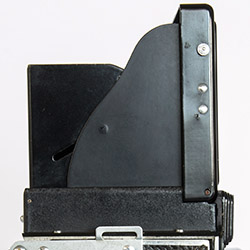
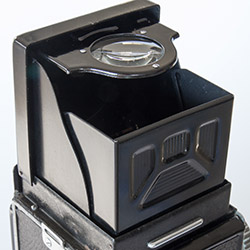
Later cameras have the magnifier release towards the front of the hood and a square shaped magnifier frame which basically fills the whole of the focusing hood:
This change occurred at about halfway in my database record (between cameras 219xxx and 220xxx) but there appears to have been an in-between step. The first four examples in my database with the new square magnifier, all with 220xxx serial numbers, still have the rear-set release buttons but also already have the holes towards the front of the hood used for the release button on later cameras.
From the beginning, the rear of the focusing hoods were plain. Short, parallel bars in black appear on eleven examples starting with camera 221xxx with the rest between 222xxx and 255xxx. Generally, this variation eschews the silver hood rest bar already in place on earlier examples and found on all later Yashima/Yashica TLRs, except the first Yashimaflex type which shares this style Pigeonflex hood (fourth pair below). There are also at least two examples without either the parallel bars or the hood rest bar. This is in addition to the examples with the knobs noted further below.




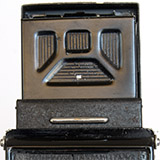
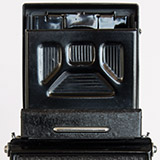
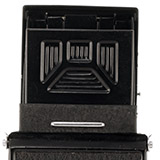
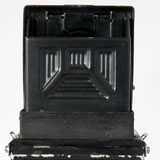
(Third pair of images courtesy of Tom Heckhaus)
Note also that the hood blinds of the last two cameras are already similar to later models except that they don't have the cut-out for the sports finder. The first two examples, fourth earliest Yashima Seiki type, serial number 257741 (different serial number range, see below), and early Yashima Kōgaku Seiki type, serial number 218019, have more bars in the three panels. This is a feature of all the early type hoods with rear-set magnifier release buttons including the first four with square magnifiers already but still with rear-set buttons mentioned earlier plus a slightly later camera 221xxx. Eagle-eyed correspondent, Tom Chandler, has noted there is a difference in pressings between these two early types (more obvious in higher resolution photos). His example is from about the middle of the Yashima Seiki range and is still the first type.
A very late variation, 12 found (up to eight belong to the version without maker name on the nameplate), has a plain focusing hood like the earlier type but no hood rest bar like the second type and adds a small silver knob to provide a finger grip:
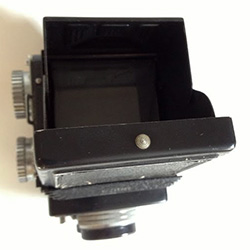
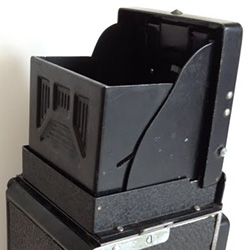
(Images courtesy of Sandu Baciu)
Focusing Knob with Black DoF Scale
Three Pigeonflexes have been found with the depth of field (DoF) scale behind the focusing knob in black with white numerals (reverse of common Yashima type). These are two Pigeonflex examples without maker name (see picture above, story below) with serial number right at the end of the 224xxx series and with lenses in the 263xxx to 265xxx range and a Yashima Kōgaku Seiki type Pigeonflex, almost at the beginning of the following new number series starting with 253xxx and with taking lens number 264xxx, i.e., they are almost next to each other in my database. Third camera shown:
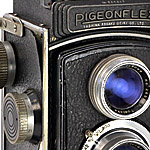 (Detail from larger web image)
(Detail from larger web image)
They have some company. The black DoF scale features on five very early Yashimaflex examples found in the wild and also in at least one ad and in another publication of some sort. The lens numbers are in a very similar range to the Yashimaflex examples. Note that the three Pigeonflex examples have the finer knurling on the knobs of the Yashimaflex/ Yashima Flex rather than the typically coarser Pigeonflex style. This seems like a short lived experiment when the Yashimaflex was first released and Yashima was still making Pigeonflexes.
Yashima Pigeonflex Without Maker Name
As noted above, there is a late version of the Yashima Pigeonflex which is otherwise identical but has no maker name on the nameplate. This example belongs to correspondent Rick Sweeney:
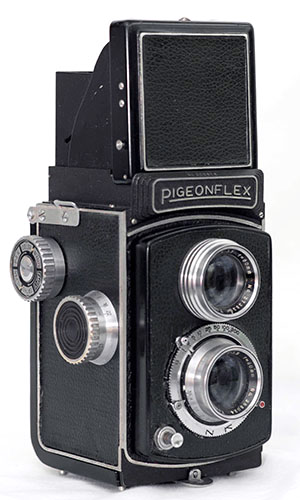
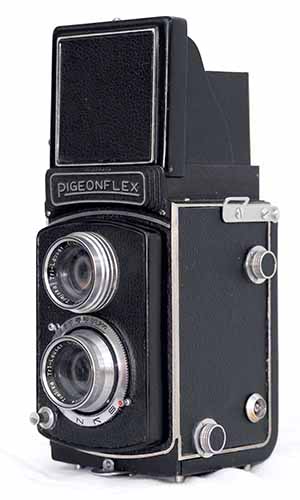
(Images courtesy of Rick Sweeney)
There are seventeen examples in my database plus an eighteenth without clear serial numbers. Note that the underlined name is also the flatter last Yashima style from above whereas the Shinano model IA and the later I and IB/IC return to the more pronounced curve of the earlier Yashima Pigeonflexes. Lens and shutter specs also match and body serial numbers are 6 digit. There is no information about the sequence of events that occurred when Yashima decided to introduce and market the Yashima Flex itself. If Yashima continued to manufacture the original Pigeonflex for a while after releasing the Yashima Flex (according to Camera-wiki.org, the Yashima made Pigeonflex was advertised from March 1953 until May 1954 and the Yashima Flex was released in October 1953), I can imagine scenarios where neither the Pigeonflex marketing company, Endō Sashin Yōhin, nor Yashima would want Yashima's name to appear prominently on the nameplate.
However, there is a little twist. It would be expected that these cameras are from the end of Yashima production but most but not all the the body serial numbers are a little earlier. There are eleven of them with body serial numbers in the range of 2241xx to 2243xx. This puts them right at the end of the complete serial number range 215xxx to 224xxx. Then there is a new range starting with 252xxx and ending at 256xxx, some 3,000 cameras in production terms. The first half or so revert to the “Yashima Kōgaku Seiki” maker name and earlier “Tomioka Opt. Co. Tri-Lausar” lens name before the abbreviated form of “Tomioka Tri-Lausar” returns and then the last examples are again without maker name.
The cameras without maker name and earlier body numbers all have lens numbers that match cameras from the end and three of them also have the knobs instead of bars on the backs of the focusing hoods already. To me it appears that all the examples without maker name are indeed late cameras but for some reason, the numbering has got out of order.
Trim & Feature Changes - By Serial Number
I have one hundred and twenty Yashima attributed Pigeonflexes in the database plus up to eighteen without a maker name (one has a case strap across the nameplate) that are also certainly made by Yashima. As noted further above, the highest serial numbers belong to four of the first five cameras (one not visible) - clearly that by trim and lens numbers on at least two of them. The earliest example in my database is 257617. Its lens numbers both begin with 253xxx and is followed by a camera with 254xxx lens numbers, both cameras featuring unique shutter trim. The third earliest example belongs to contributor Sandu Baciu and has serial number 257715, with taking lens dropping to 243174 and viewing lens 243190. The fourth camera appears to have serial number 2577xx with the last two digits also in the teens (lens numbers not discernible). Not far behind is my 257741 with taking lens 243159 and viewing lens 243236. The lens numbers of Sandu's and mine are the lowest of any Yashima Pigeonflex.
There are another eight cameras with lenses in the 243xxx to 244xxx range without visible body serial numbers. Then is the first camera of a new numbering range, 215xxx with taking lens 245xxx and camera 216xxx followed by several in the 217xxx range. There doesn't appear to be any obvious reason or trim change associated with the numbering change.
Starting with camera 217xxx and taking lens 248xxx, the maker on the nameplate was updated to “Yashima Kōgaku Seiki Co., Ltd.”
The focusing magnifier changed to the later square type with camera 220xxx but the first two still have the rear-set release buttons. Camera 223458 has taking lens 265836 and viewing lens 265493 and is the first with the simplified “Tomioka Tri-Lausar” lens name. There is one more 223xxx and then the first five examples without maker name, all 224xxx with two examples with lens numbers in the 269xxx to 270xxx range (near as high as the last lenses get) before the body serial numbers make a 29,000 leap to 253xxx. Again, I haven't been able to identify any obvious trim change which aligns with the jump. There is no leap in lens numbers and in fact they are generally lower in the range between 258xxx and 260xxx and revert to the earlier “Tomioka Opt. Co. Tri-Lausar” name. By camera 255xxx and what looks like 256xxx, everything is back up to date again with lens numbers in the 267xxx to 268xxx range and the later abbreviated lens name.
There are two 255xxx cameras without maker name and then two 256xxx cameras with “Yashima Kōgaku Seiki Co., Ltd.” again.
The last five cameras in my database don't have discernible body serial numbers. Four don't have a maker name and one has a case strap across the nameplate, making it anonymous in this regard. The lens serial numbers range from 268xxx up to the highest lens number, 273xxx (viewing lens), so I have placed these cameras here but they could just as easily belong with the other cameras without maker name with body numbers in the 224xxx range. Three of them have the knob finger grip on the focusing hood and the other two don't have the rear of the hood visible.
Yashimaflex/ Yashima Flex
Yashima go it alone
Probable release date |
Oct 1953 |
Probable end date |
mid 1954 |
Lens |
Filter Mounts |
Frame Counter |
Shutter |
|||
Make/Type |
Sync |
S/Timer |
Speeds |
|||
Tri-Lausar |
32 mm |
Red Window |
SYK (STK?) |
Yes |
Yes |
B,1-1/200 |
Tri-Lausar |
32 mm |
Red Window |
NKS |
Yes |
Yes |
B,1-1/200 |
Tri-Lausar |
32 mm |
Red Window |
NKS-TB |
Yes |
Yes |
B,1-1/200 |
Tri-Lausar |
32 mm |
Red Window |
NKS-FB |
Yes |
Yes |
B,1-1/300 |
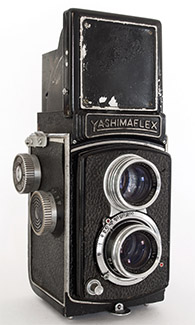
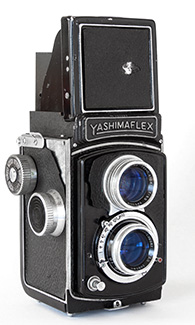
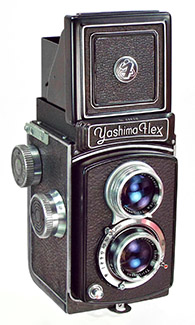
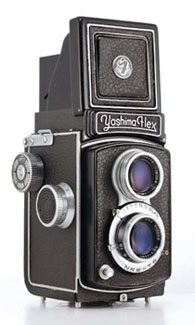
(Third image, courtesy of Chris Whelan, fourth image courtesy of Tom Heckhaus)
The Yashima Flex was the first Yashima made camera to bear its name. Basically, it was a Pigeonflex with a new name and minor trim updates but they didn't all happen at once. The top two cameras are two of only a total of ten very early types found so far. The first camera is owned by Tom Heckhaus (my photo), the second is one of two early types from my collection. All ten early examples still have a a Pigeonflex style nameplate with “Yashimaflex” written in capital letters as one word and at least eight still have a Pigeonflex type focusing hood without sports finder or logo. My other example (not shown) has the highest serial number of the three where it is clearly visible but second lowest lens numbers. Its focusing hood is either the very last type Yashimaflex (see further below), or more likely from a later model as the screw holes have been crudely elongated so it is obviously a replacement.
The two cameras on the bottom row have the general appearance of a typical Yashima Flex but even so, there were several hood variations (only visible from the rear) and the shutter changed from NKS to NKS-TB to NKS-FB. The hoods on this pair have some minor differences and the left one has an NKS shutter and the right, the later NKS-TB shutter. They have the two word form of the name, “Yashima Flex” (see Model Names), on a textured nameplate, sports viewfinder and hood logo for the first time (note, I will use “Yashima Flex” when referring to the model generally or the later version in particular and “Yashimaflex” when specifically referring to the first type).


(Right image courtesy of Tom Heckhaus)
The Yashimaflex Type
The first camera above exhibits all the early features plus a few of its own. It has the earliest lens numbers, 262147 and 262740, but there is no serial number on the nameplate or anywhere else on the camera. Prototype comes to mind but this camera was found with a matching early case and unique lens cap (featured in the relevant sections) and therefore I believe it was made for sale. Yashima had been making Pigeonflexes for someone else (Endō Camera Stores), perhaps to their specs and requirements, so who knows what they were thinking for their own first camera. There were other Japanese TLRs without body serial numbers.
The tripod mount of the first camera still has the the 2 rings of the Pigeonflex whereas the other examples with tripod mount visible have the later 4 rings typical of the Yashima Flex:
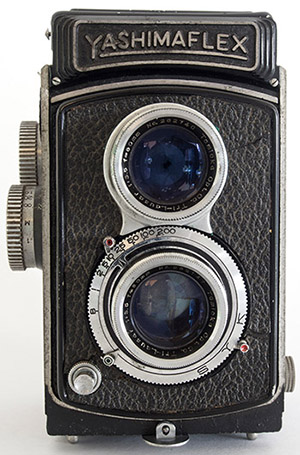
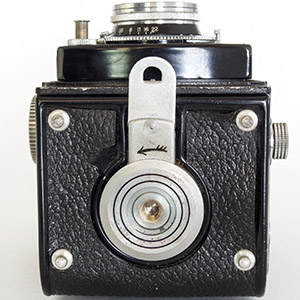
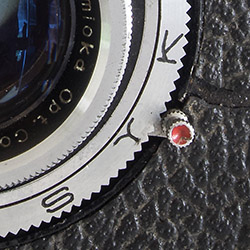
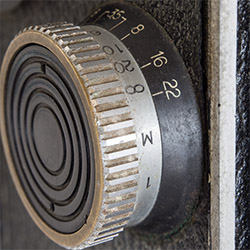
The biggest difference between this camera and all other Yashima made cameras is the shutter. Pigeonflexes have an NKS shutter as do most early Yashimaflex/ Yashima Flex examples before changing to the NKS-TB. This camera has an SYK shutter. It is a strange font so it could conceivably be an STK but either way, all searches draw a blank as far as shutters are concerned. However, it is possible that the letters could be related to pre-War S.Y.K Palma cameras made by Kyūreidō (Camera-wiki.org - check the ads full-size, “S.Y.K” appears in English in each one). The shutter trim detailing on this and the NKS example below and one other is pretty near identical, halfway between Pigeonflex and the later Yashima Flexes whereas the other cameras are already like the Yashima Flexes. I called the SYK font “strange” but closer inspection reveals that it is identical to the NKS font for the “K” and “S” letters. So maybe there is some connection somewhere.
The DoF scale behind the focusing knob is black with white text on the the first, third, fourth, fifth, seventh and ninth Yashimaflex examples but not the second, sixth, eighth or tenth. I have also found three Pigeonflex examples with the black DoF scale - two with body serial numbers right at the end of the 224xxx series with lenses in the 262xxx to 265xxx range and the third is almost from the beginning of the new number series with body number 253xxx and taking lens number 264xxx. They are from latish production so probably would line up with the Yashimaflex examples - the lens numbers are a close match. All other Yashima cameras are silver with black text, except the Yashicaflex C which used red text, until the new style knobs and scales arrived in 1956 .
Inside, the film pressure plate of the first, second, fourth and sixth cameras is the plain Pigeonflex type whilst the fifth camera has the ribbed type with a pattern that continued up to and including the Yashica 12 (the pressure plate types of the sixth to tenth examples are unknown). Below are more photos of the second camera above (note the later 4 ring tripod mount and “normal” black text on silver DoF scale):
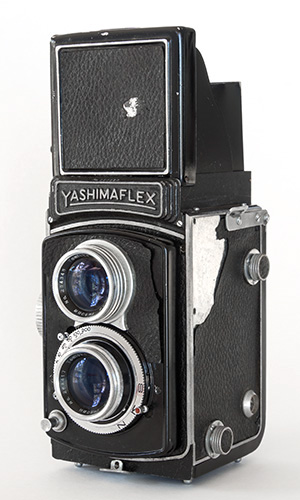
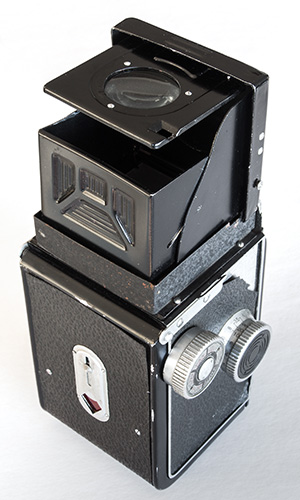
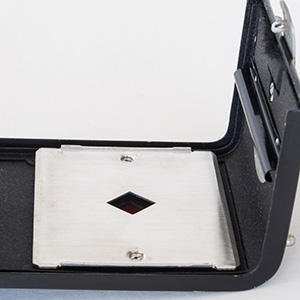
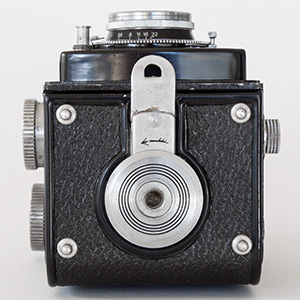
By body serial number, this is the second of the nine examples found but it has the third highest lens numbers. This camera and the eighth and ninth examples feature the simplified “Tomioka Tri-Lausar” lens name found on most later Pigeonflexes and all the later Yashima Flexes. On the tenth camera, only “Tomioka” is visible. The other six cameras, including the first, have lenses named “Tomioka Opt. Co. Tri-Lausar”. Both the lens naming schema of the six with “Tomioka Opt. Co. Tri-Lausar” and lens serial numbers of all ten put them a little way back into Pigeonflex examples in my database suggesting some production overlap. In other words, Yashima continued to make Pigeonflexes for a while after releasing the Yashima Flex - no surprise there and consistent with some other references.
Eight of the ten early examples already have the more finely knurled knobs of the later Yashima Flex but oddly, the sixth and the tenth have the coarser Pigeonflex type. They all have the small silver coloured trim plate between the lenses. The seventh camera of the ten by lens numbers (featured on a Japanese blog site) has an accessory shoe but I am reasonably certain that this is not original - it sits much higher than on other Yashima Flexes, or other models from the period, and does not appear to be the extruded alloy type of Yashima Flexes with the later nameplate. Eight other examples don't have accessory shoes and there is no evidence of one ever having been fitted to them. On one camera, that side is not visible.
The table below summarises the serial numbers found and some of the differences between the nine Yashimaflexes and compares them to later Yashima Flex types. Note that the subsequent Yashima Flexes have 5 digit body serial numbers:
Serial Number |
Taking Lens |
Viewing Lens |
Lens Maker Name |
Shutter |
DoF |
Bottom Rings |
Nine Early Yashimaflex Examples |
||||||
None |
262147 |
262740 |
Tomioka Opt. Co. |
SYK |
Black |
2 |
220220 |
264417 |
264346 |
Tomioka |
NKS |
Silver |
4 |
220283 |
263501 |
263547 |
Tomioka Opt. Co. |
NKS |
Black |
4 |
2203xx |
264xxx |
264xxx |
Tomioka Opt. Co. |
NKS |
Black |
4 |
260081 |
263543 |
263862 |
Tomioka Opt. Co. |
NKS |
Black |
4 |
2601xx |
264xxx |
263xxx |
Tomioka Opt. Co. |
NKS |
Silver |
4 |
264xxx |
Tomioka Opt. Co. |
NKS |
Black |
|||
264xxx |
Tomioka |
NKS |
Silver |
|||
265xxx |
265xxx |
Tomioka |
NKS |
Black |
||
2xxxxx |
266xxx |
only “Tomioka” visible |
NKS |
Silver |
4 |
|
Typical Later Yashima Flex Examples From Earliest |
||||||
341xx |
269xxx |
270xxx |
Tomioka |
NKS |
Silver |
4 |
To Latest |
||||||
447xx |
291xxx |
292xxx |
Tomioka |
NKS-FB |
Silver |
4 |
The lens serial numbers of all ten Yashimaflexes are close but the body serial number of the fifth and sixth cameras are some 40,000 higher than the second, third and fourth cameras (the seventh to tenth camera body numbers are not discernible). Obviously a numbering change for some reason.
A Yashimaflex camera with the same early nameplate and Pigeonflex hood as these examples, plus the black DoF scale of six of the examples, appears in an ad in the February 1954 edition of Japanese photography magazine “Ars Camera”:
 (Detail from larger web image)
(Detail from larger web image)
Another early example has surfaced on a Korean website. This looks like a retouched version from an ad or brochure. This example has the new style two word nameplate already but retains the Pigeonflex focusing hood without sports finder and it still has the unique black DoF scale, i.e. it is a little further along the evolutionary scale but not up to what we are familiar with yet:
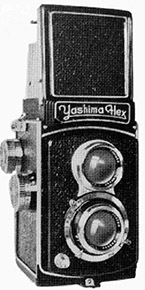 (Detail from larger web image)
(Detail from larger web image)
Evolution of the Yashima Flex Type
The next examples in my database have the two word form of “Yashima Flex” on the nameplate, a sports finder and the new stylised “Y” Yashima focusing hood logo for the first time. The DoF scale is silver with black text and the lens names are the simplified “Tomioka Tri-Lausar”. The first twelve cameras of this type in my database still have the first type NKS shutter (there is the odd example with NKS shutter interspersed with later cameras as well). Where visible, most of these and early NKS-TB examples up to serial number 384xx also have a different focusing hood assembly to both earlier and later cameras (there are three exceptions - see below). The parallel bars on the back of the hoods, whilst similar to later examples and future models, have one long continuous silver bar on the bottom and a split bar on top:
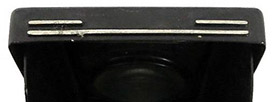 (Detail from larger web image)
(Detail from larger web image)
A bigger difference with these cameras is that they also have a different magnifier and a completely different “U” shaped pressing on the rear panel of the focusing hood blind which somewhat resemble the Rolleicord III style and the complete assembly looks very similar, if not identical, to the Shinano Pigeonflex Model IA:
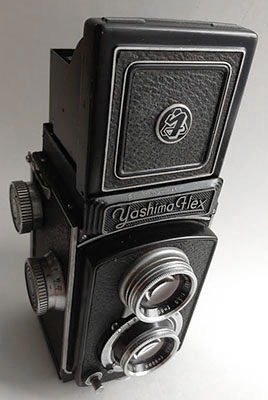
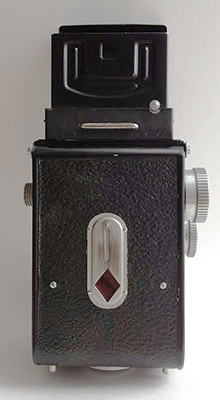
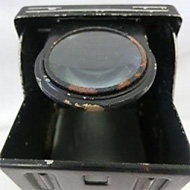
(First two images courtesy of Sandu Baciu, 3rd image is detail from larger web image)
The style is unique to this Yashima Flex variant and we can only speculate about the reasons for it. The differences between this camera and the Shinano Model IA are probably less than the similarities. As well as the hood assembly, the red window housing (which originated with the original Pigeonflex) looks very similar except that the Shinano has a round window and the Yashima a diamond shaped window. The Pigeonflex Model IA is clearly Shinano made, the lenses are marked “SHINANOKōKI PIGEONAR”. Perhaps some of these items were bought in from outside suppliers or there was some level of cooperation as Shinano commenced Pigeonflex production?
Earlier, I mentioned three exceptions. They are the only examples so far found of a third type and sit about 2/3 of the way through the Model IA-like group above with “U” shaped pressings. Two cameras in my database with the NKS shutter and the first with NKS-TB have a hood blind which is the same style as all later cameras until the reinforcing panels changed from three to two in 1957 (i.e., like the late Pigeonflex but with hole for the sports finder). However, they have Pigeonflex-like short parallel bars on the rear of the focusing hood, albeit in silver. The example with first NKS-TB shutter is featured:



(Images courtesy of Tom Heckhaus)
This camera also appears at the top right of this section.
The silver bars appear to be more crudely machined, or even filed, than bars on other models:

Below is an example of a later type Yashima Flex with the long parallel bars:
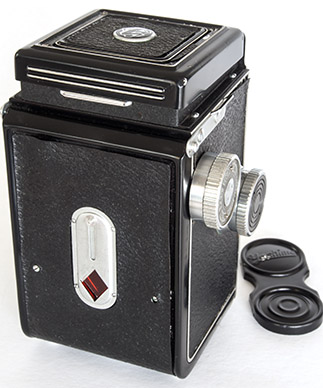
Near the end of its production run, the Yashima Flex received the further updated NKS-FB shutter with top speed increased to 1/300 sec. The flash sync socket remained the ASA type throughout. This model introduced the silver dress ring with “coat tails” around the viewing lens to integrate the appearance of the two lenses. Except for four late cameras with NKS-FB shutters and two with NKS-TB shutters, there are no retaining screws unlike most of the following Yashicaflex Model B examples which have a screw at each side at the bottom. Accessory shoes are covered here. The style is unique to the Yashima Flex (four late examples have the black insert of the Yashica Flex B, see below):
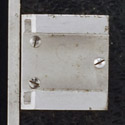 (Image courtesy of Tom Heckhaus)
(Image courtesy of Tom Heckhaus)
All, except the first Yashimaflex example, have four rings in the tripod mount like the following early type Yashica Flex B.
The Yashima Flex's Place in Time
The Yashima Flex is claimed to be released in October 1953 and “replaced” by the same spec Yashica Flex B in December 1953 already. The two nameplate styles, four shutter variations, the four or so focusing hood variations etc and the February 1954 ad above featuring the first type all suggest that the model was around for much longer. Another 1954 ad featuring a later type together with well known Japanese actress Fumiko Wakao:
 (Detail from larger web image)
(Detail from larger web image)
A Japanese site has advertised four periodical publications or magazines from 1954:
.jpg)
A Google translation of the fourth issue is below. Note that it features the Yashima Flex in what appears to be one of its reviews. I doubt that such a publication would come out more frequently than once a month and it could also be bi-monthly or even quarterly, given the four 1954 issues. It certainly suggests that there was no early finish to Yashima Flex production.
.jpg)
(Both images are detail from larger web images)
There is no obvious reason why the Yashima Flex would remain in production after the Yashica Flex B was introduced, it was simply a nameplate change after all. Updates to the Yashica Flex B are not paralleled by the Yashima Flex (no film start marks, albeit “inert”, in an otherwise identical body, no change of tripod mount ring styles from four rings to three, no change from ASA to PC flash sync socket or upgraded NKS-FB shutter until the very end). Most importantly, both the Yashica Flex B body and lens serial numbers appear to simply continue on from the Yashima Flex serial numbers. Yet the following ad is for the Yashima Flex and Yashica Flex S (not the earliest version either) together in the December 1954 edition of Swedish photography magazine Nordisk Tidskrift för Fotografi:
(Document image courtesy of Göran Årelind)
(Click on ad for larger view)
Is it simply a mistake (e.g. inserting “Yashima Flex” instead of “Yashica Flex B”; by the shutter specs, it has an NKS-FB type which could be either camera - Molander and son did mix up some ads later, see the Yashica-Mat entry), old stock, or are some of the early dates a bit out? There is no way to be certain. Given the apparent existence of a very early Yashica Flex S prototype (see Yashica Flex S), there must also remain the possibility that the model S was released before the model B. Of course, that goes against accepted wisdom but in the following Yashica Flex B entry is a table of Tri-Lausar lens numbers for the three models which could suggest that Yashica Flex B lens numbers are higher than both the late Yashima Flex and early Yashica Flex S numbers.
Trim & Feature Changes - By Serial Number
The first four cameras in my database are the early “Yashimaflex” nameplate type detailed earlier with body numbers ranging from not present to 6 digit 260081 and lens numbers from 262147 to 264417. It is likely that all following cameras have 5 digit serial numbers. The fifth camera, with taking lens number 272xxx, has the new nameplate already, sports finder and accessory shoe. The sixth camera looks like 34xxx and the taking lens is 272xxx again. The seventh camera looks like 35xxx and the lens may be 27xxxx. The eighth camera also looks like 35xxx and the lens may be 269xxx which seems a little low but its viewing lens is 277xxx which seems a little high. The ninth example is also 35xxx with viewing lens 27xxxx and then there are several with 274xxx lens numbers. Except for one camera with a replaced hood from a 1957 or later model, these cameras have the Shinano Pigeonflex IA-like focusing hoods. All still have an NKS shutter. A camera with only taking lens prefix “27” of 27xxxx visible and another with body number 370xx and both lenses in the 275xxx range plus the first camera with the NKS-TB shutter, 37xxx also with lenses in the 275xxx range, are the only three examples with rear focusing blind with three panels but hood with short Pigeonflex like parallel bars in silver. The following cameras revert to the Pigeonflex IA-like focusing hoods but now mostly with NKS-TB shutters until camera 38xxx with taking lens 278xxx and viewing lens 279xxx which both reverts to an NKS shutter and is the last with this type focusing hood. Two later cameras, 39xxx and 40xxx with taking lens 282xxx, also have NKS shutters.
The first example with NKS-FB shutter appears at around 42xxx (estimated from lens numbers), then there is a mix of TB and FB types from 43xxx to 44xxx numbers. The highest lens number is 293xxx. Four examples with NKS-FB shutters and 44xxx serial numbers have the screws in the coat tails of the trim between the lenses that is commonly associated with the Yashica Flex model B.
Then there is one more camera with very clear serial number 608xx. Unfortunately, lens numbers are not discernible. It has an NKS-TB shutter. This is a real mystery camera as the Yashica Flex model B numbers seem to carry on from the Yashima Flex with 45xxx and 46xxx numbers. At this stage, I am not going to add it to the Serial numbers page.
Yashima Flex ad in English with Japanese addresses and pricing, claimed by a Japanese auction site to be from an unnamed 1954 US publication, probably for US personnel stationed in Japan:
 (Image courtesy of Chris Whelan)
(Image courtesy of Chris Whelan)
Yashica Flex B
aka Yashicaflex B (old model)
Probable release date |
mid 1954 |
Probable end date |
early 1955 |
Lens |
Filter Mounts |
Frame Counter |
Shutter |
|||
Make/Type |
Sync |
S/Timer |
Speeds |
|||
Tri-Lausar |
32 mm |
Red Window |
NKS-FB |
Yes |
Yes |
B,1-1/300 |
.jpg) (Cover of Japanese user manual from larger web image)
(Cover of Japanese user manual from larger web image)
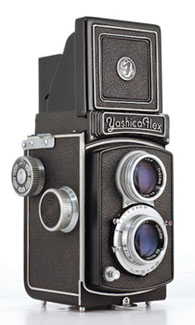 (Image courtesy of Tom Heckhaus)
(Image courtesy of Tom Heckhaus)
The most significant change from the last version of the Yashima Flex with the improved NKS-FB shutter and 1/300 top speed is the nameplate. Also, the taking lens bezel is devoid of black trim but the accessory shoe received a black insert, details are covered here (note that at least thirteen earlyish examples in my database are devoid of the black insert, not every one, more like every second one - it's not possible to say whether they left the factory that way but it seems likely):
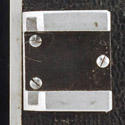 (Image courtesy of Tom Heckhaus)
(Image courtesy of Tom Heckhaus)
Intriguingly, a very early example, perhaps the earliest (serial number 4x1xx, lenses 292xxx and 293xxx) has an NKS-TB shutter. There is no way to tell whether this is original or a replacement (noting that late Yashima Flexes already received the NKS-FB type).
The number of black rings in the tripod mount was initially four thin rings like the Yashima Flex and then three with two thin close spaced outer rings and a thicker inner one:
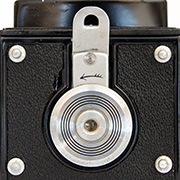

(Right image courtesy of Tom Heckhaus)
Found in roughly equal proportion, both styles are also found on Yashica Flex S examples with NKS-FB shutter with the four ring type changing to three ring in the middle of production. A little less than halfway into the model B production run, the flash sync socket was changed from the ASA type to the PC (Prontor-Compur) type which was slowly becoming the de-facto standard. This seemed to occur at a similar point of production of the Yashica Flex S with NKS-FB shutter.
Like the Yashima Flex before it and also the Yashica Flex S with Tri-Lausar lenses, the name on the lens was initially “Tomioka Tri-Lausar” but on later examples, it changed to simply “Tri-Lausar” (perhaps at the time the Yashica Flex S changed to Heliotars?). The “Tomioka Tri-Lausar” lenses use six digit serial numbers which appear to continue on from the Yashima Flex. The “Tri-Lausar” lenses introduced new five digit serial numbers. Most of the cameras with six digit Tomioka Tri-Lausar lenses have five digit body numbers commencing with “4” and those with five digit Tri-Lausars have five digit body numbers commencing with “5”. But there are some cross over examples, including one with one name/ serial number style on one lens and the other style on the second lens and a second example with the styles reversed. Camera with earlier 6 digit Tomioka Tri-Lausar lenses on left and camera with later 5 digit Tri-Lausar lenses on right (note, left camera has an accessory shoe from a later model):
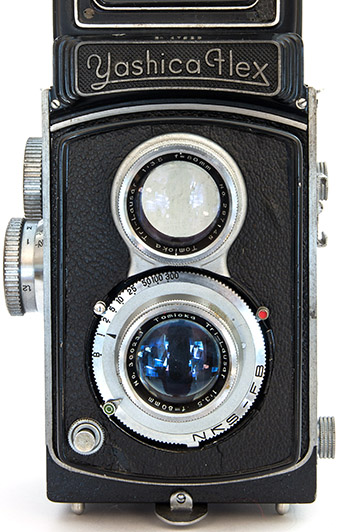
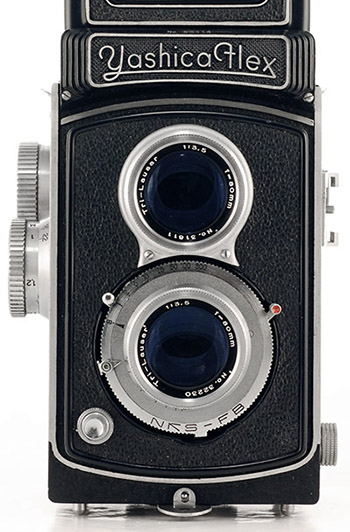
(Right image courtesy of Tom Heckhaus)
This pair also illustrates the mystery of the viewing lens dress ring “coat tails” first introduced by the Yashima Flex. The Yashica Flex B added external fixing screws. However, thirteen cameras spread throughout the first half of my database don't have them. If they were all early cameras, it would make sense. Also, the original source brochures for the scans below clearly show a camera without the screws.
Note that Japanese Wikipedia and some other sites, probably all using the same source, claim that the Yashica Flex B adopted a Copal shutter with 1/10 to 1/200 speeds. This is clearly a mistake. No such examples have been found and those specs clearly identify the shutter as the later budget type fitted to the first Yashicaflex A series cameras. Losing the self-timer, slow speeds and 1/300 top speed would have been a massive downgrade. I suspect a Yashicaflex A-I has been mis-identified at some point. The A-I was a very rare model in Japan, only the very first Y.S.K. shutter and Copal shutter with black lens board trim types have been found. Except for the silver coat tails and nameplate script, the B and early A look very similar. The A-II version, released at the same time as the A-I, featuring auto-stop winding and film counter is the one that is overwhelmingly found on Japanese auction sites today. In Japan, it seems to have been marketed as the Model A, probably because the A-I became export only.
Its Name and Place in Time
Commonly referred to as “Yashicaflex B (old model)” but I believe released and for most of its life with the two word form (see “Model Names”), why the need for a “B” for the first (and only at that point) Yashica Flex? Because they are so similar to each other, there is almost certainly no model between this one and the Yashima Flex. Why “B” and why “B” before “A”? It is possible that Yashima was already thinking about introducing a budget line with the “A” nomenclature (there were quite a few; A-I, A-II, AS-I, AS-II, A-III, A2, A new model and finally, Yashica A and Yashica A-III) and that “B” was planned to denote a mid-range camera line (one initially based on the Yashima Flex already in production); there was the Yashica Flex B and subsequent Yashicaflex B (new model) and Yashica B, all with different feature sets but neither bottom nor top spec models at their time. Then there were the top spec models without exposure meters, when released, Yashicaflex C and Yashica C. I emphasise, that I am just guessing!
Here are the fronts of two versions of a Japanese flyer for the Models S & B (the first brochure lists the basic specs, the red text blocks in the second add some marketing hype and the red text under the cameras translates to something like “three years full warranty” pretty spectacular for 1954!):

.jpg) (Right scan courtesy of Chris Whelan)
(Right scan courtesy of Chris Whelan)
(Click on images for larger 2 page PDFs of flyers)
These confirm that the “B” nomenclature was official Yashima naming and not just collector invention to name an “unknown” Yashica Flex model. Contributor Chris Whelan has translated the title to mean “New Products of the World”, again implying that the two models are a similar vintage. The “S” was 20,000 yen and the “B” was 15,000 yen, both with cases. The pricing and features clearly separate them into different market segments. Both are confirmed with “German-style” flash sync, i.e. PC type whereas both models were released with the earlier ASA type sync. I would say that the original version of the brochure is older than August 1954, one of the girls from the group on the back is featured in the viewfinder of the camera on the cover of the August 1954 edition of Photo Art featured on the Yashicaflex S page.
Below is a brochure featuring a slightly later Yashica Flex model S on the front (serial number 30098, same as on the English language user manual cover) and a model B on the reverse:
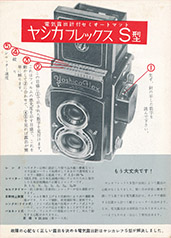 (Scan courtesy of Chris Whelan)
(Scan courtesy of Chris Whelan)
(Click on image for larger 2 page PDF)
Contributor Göran Årelind discovered this ad in the March 1955 edition of the Swedish photography magazine, Foto:

(Document image courtesy of Göran Årelind)
This proves that the Yashica Flex B was still being marketed several months after the budget Yashicaflex A series was released in October 1954. Although the B had the earlier shutter, it had a self-timer and 1-1/300 speeds instead of the more limited 1/10-1/200 on the A series. The Yashimar lens of the A series was also only ever found on budget models. In other words, the A series was a new bottom tier level, not a replacement for the B. The B probably simply withered with competition from the plethora of A series models, including models with exposure meters, and the more expensive model S. Its natural replacement was probably the Yashicaflex model C which included some of the model S features like Bay 1 lens mounts.
In “Start Marks”, I noted that the Yashica Flex B was the first model to feature cast film start triangles even though it had no need of them (not painted red, or used, with cameras with red film counter windows). They are not there on the earliest examples, which start from 451xx, but are there from 472xx onward. Any remaining supplies of other-wise identical Yashima Flex bodies would undoubtedly have been used up first.
This is camera 52753 from the second half of production but it is the same as my 47259 with the earlier lens names from the first half of production:
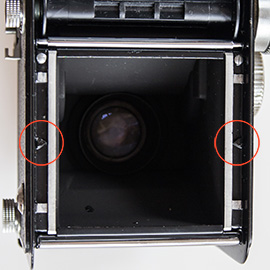
As evidence from features such as the the number of rings on the tripod mount, adoption of the PC flash sync socket at a similar time and the introduction of film start marks mount, I am starting to believe that the two models were released at, or very near, the same time. Commonly quoted release dates for the Yashima Flex and Yashica Flex B are October and December 1953 respectively. I have already noted that the Yashima Flex certainly remained in production far longer than a few months and it was still being advertised in February 1954 and possibly later (see the December 1954 Swedish ad in the Yashima Flex entry). The Tri-Lausar lens serial numbers seem to logically progress from Pigeonflex to Yashima Flex to Yashica Flex B and what's more, the early Yashica Flex B and early Yashica Flex S seem to share the same series numbers and lens naming convention.
Below is a table of taking lens and viewing lens (simply to give a better spread) serial numbers of the first examples of both the Yashica Flex model B and S in increasing order. There may be a number of cameras with the same first three digits but the serial number is only listed once. Both have “Tomioka Tri-Lausar” lenses and NKS-FB shutters. Just for fun, I added other columns for late Yashima Flex examples from the time of the appearance of the first NKS-FB shutter, although a couple of late NKS-TB types with higher serial numbers are also included. After these examples, the Yashica Flex model B changed to 5 digit serial numbers without the “Tomioka” and the model S to Heliotars. The Yashima Flex ceased production.
Yashima Flex |
Model B |
Model S |
|||
Taking |
Viewing |
Taking |
Viewing |
Taking |
Viewing |
286xxx |
286xxx |
285xxx |
278xxx |
287xxx |
287xxx |
288xxx |
287xxx |
287xxx |
288xxx |
288xxx |
288xxx |
289xxx |
290xxx |
291xxx |
293xxx |
289xxx |
290xxx |
291xxx |
292xxx |
294xxx |
294xxx |
291xxx |
293xxx |
292xxx |
295xxx |
296xxx |
292xxx |
294xxx |
|
296xxx |
297xxx |
293xxx |
296xxx |
||
297xxx |
298xxx |
296xxx |
297xxx |
||
298xxx |
299xxx |
297xxx |
|||
299xxx |
299xxx |
||||
300xxx |
|||||
As noted earlier, Yashica Flex model B body serial numbers appear to continue on from the Yashima Flex and therefore it can be assumed that lens numbers should more or less follow too. Because lens and body numbers rarely align precisely, the small overlap is within normal Yashima/Yashica tolerances. Certainly, the lens numbers in the table are all from within a short period of each. The model B and model S align almost completely for the duration of “Tomioka Tri-Lausar” named lenses.
The close relationship between the models B and S continues with the boxes:
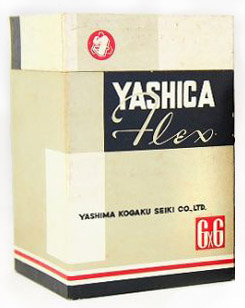
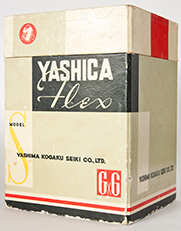
(Detail from larger web image on left)
The box without model name belongs to a Yashica Flex B for sale as a complete kit with camera, case and matching lens cap. The model S box belongs to an early bodied example with Copal shutter already, boxes for later examples have completely different graphics. Reference to Boxes will confirm that they are remarkably similar to each other compared to most other models from the period (later model S boxes changed to predominantly black to match the model AS-II).
Both the early Yashica Flex model B and S ever-ready cases have a gold coloured lining material and the top front corners of the half-cases are rounded. Later cases for both models, plus for all the A series cameras, have a red lining and 45 degree angled corners (see here).
My conclusion is that the Yashica Flex model B was released sometime after February 1954 at the same time, or very near the same time, as the Yashica Flex model S which we now know appeared on an August 1954 magazine cover and was probably released a few months earlier. They were given separate model names which otherwise would not have been needed. They appeared together in several Japanese brochures and a Swedish ad. They shared body, shutter and lenses, including lens serial numbers, as well as trim and flash sync details. The model B was a typical basic TLR model competing for volume on price in the mass market and the model S was the flag ship product bringing attention and acclaim, and probably higher margins, to the fledgling company.
“Made in Japan”
The appearance, or not, of “Made in Japan” on various models is dealt with here. The first instance of it appearing on any model that I am aware of is on the nameplate of earlier Yashica Flex model S examples, but not the first ones. The first time that I have seen it inside the camera near the film feed spool is on three late Yashica Flex model B examples and on a fourth without discernible serial numbers. The last example in my database is one of the three but unlike the camera below, it has “Made in Japan” on one line:
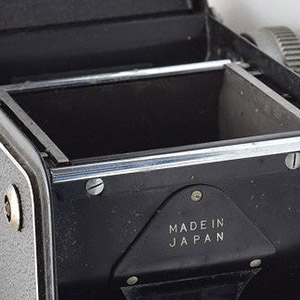 (Detail from larger web image)
(Detail from larger web image)
It is not known whether this was a general change for the model B, or only applied to export examples. There are similar examples of the Yashica Flex model S from a similar time starting with the introduction of the new textured nameplate, near the replacement of the NKS-FB shutter with the Copal type, when “Made in Japan” disappeared from the nameplate meter flap. It doesn't seem that all the model S examples from the period have it so it may be an export, or specific market, thing.
Trim & Feature Changes - By Serial Number
There are fifty nine cameras in my database. The first is 45xxx, which seems to follow on from the last Yashima Flex, 44xxx. As noted above, it is one of three without start marks. Its lenses are both in the 22xxx range and belong to the later five digit plain Tri-Lausar series without the Tomioka name. These are definitely out of sequence in one sense but they do have the lowest five digit serial numbers by far - I'm not sure what is happening there. The second example, with body number 47xxx, has six digit Tomioka Tri-Lausar taking lens, 287xxx, and viewing lens. The third, I am guessing, does not have a discernible body number but has six digit Tomioka Tri-Lausar taking lens number 294xxx and the viewing lens may be 296xxx and the fourth camera has taking lens number 296xxx and viewing lens 298xxx. The fifth example, with body number 47xxx has six digit Tomioka Tri-Lausar taking lens 297xxx.
Then there are three cameras with lenses in the 298xxx to 299xxx range, the second of which has a body serial number beginning with “4”. The first in the group is the first camera without screws in the cover plate. These are followed by 47xxx with taking lens 300xxx and viewing lens 297xxx. This is the second example without the screws in the viewing lens cover plate (the focusing knob end cap, accessory shoe and perhaps focusing hood have been replaced - is the rest original?) and the last example with ASA flash sync socket.
The last group of eighteen cameras has body numbers from 50xxx to 54xxx. The first has five digit Tri-Lausar taking lens 28xxx and six digit Tomioka Tri-Lausar viewing lens 293xxx and is the third example without screws in the cover plate. The second has six digit Tomioka Tri-Lausar lenses with numbers 286xxx and 290xxx and is the last with the earlier 4 ring tripod mount visible and the first with PC sync. The next, 51xxx (some 450 cameras later) has six digit Tomioka Tri-Lausar taking lens 275xxx and five digit Tri-Lausar viewing lens 29xxx. The rest have five digit Tri-Lausar lenses ranging from 27xxx to 35xxx. Camera 52xxx is the first with confirmed 3 ring tripod mount.
The second last camera, 54xxx, has some earlier parts, possibly from a Pigeonflex and also some Yashicaflex A series parts. It is the fourth example without screws in the viewing lens cover plate but like with the second example, it is hard to know if this feature is original. The last camera, also 54xxx, has a back with the new red window style introduced on the Yashicaflex A series cameras. It has a three ring tripod mount which is consistent with the very early A series and could be an update near the end of Yashica Flex B production - why produce two identical backs except for red window style? Or it could simply be a repair replacement.
The Yashica Flex B has a unique wide waisted, pressed metal lens cap commonly found in black (similar to the Yashima Flex lens cap). The last three examples in my database with lens caps, (all 54xxx serial numbers) have a silver version of the same lens cap. This was probably from the same time that the Yashica Flex S also changed from black to silver lens caps and new silver lens caps were introduced with A series models.
